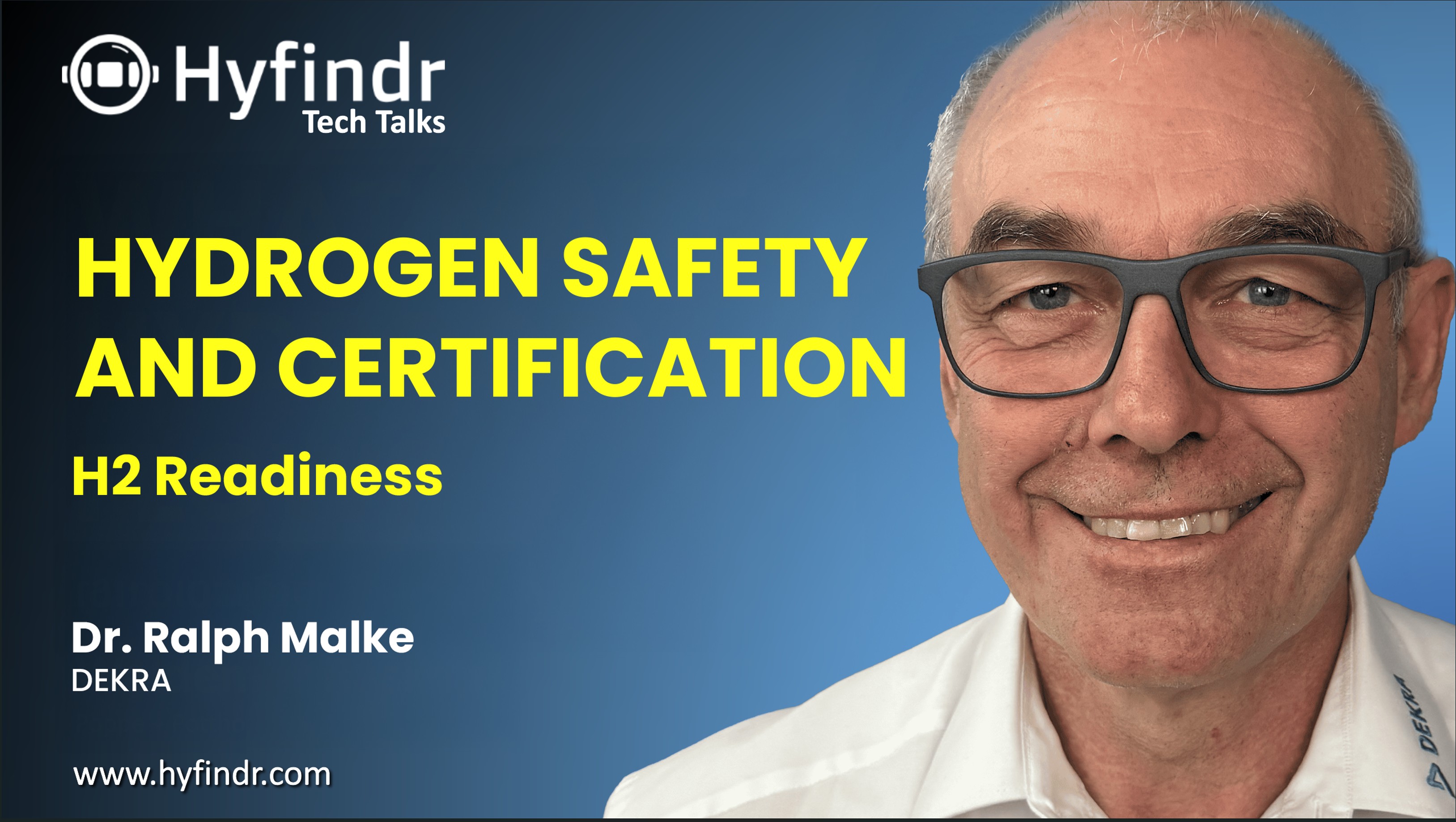In this Hyfindr Tech Talk episode, we explore what it truly means for materials and components to be hydrogen-ready (H₂ ready). Host Steven Oji is joined by Dr. Ralph Malke, a PhD in material science and senior failure analysis expert from DEKRA, a global leader in safety testing and certification.
Together, they dive into the molecular science behind hydrogen interactions with materials, the real risks of hydrogen embrittlement, how leak tightness is tested, and the rigorous steps needed to achieve H2 ready certification.
Learn About Hydrogen Material Compatibility and Safety
Hydrogen is becoming central to the clean energy transition. But using it safely, especially under high pressure and over long durations, introduces serious technical challenges.
Dr. Malke explains how hydrogen’s unique atomic properties interact with metal structures, why embrittlement is a major concern in design and testing, and what it takes to qualify materials and components for hydrogen use in sectors like energy, transport, and industry.
Key Topics Discussed in the Tech Talk
What Does "H2 Ready" Mean?
Being H2 ready means a material or component can function reliably and safely under hydrogen exposure. This includes resistance to chemical degradation, leak prevention, and long-term mechanical integrity under high pressure and dynamic stresses.
In this episode, Dr. Malke outlines common hydrogen applications, including:
-
Gas burners and household systems
-
Hydrogen pipelines and storage tanks
-
Power plant turbines
-
Mobility and transport (fuel cell and hydrogen combustion engines)
-
Electrolyzers and industrial hydrogen production systems
Hydrogen Embrittlement: A Hidden but Serious Threat
Hydrogen embrittlement occurs when atomic hydrogen (H) enters a material’s internal structure, causing it to lose flexibility and strength. Over time, this makes materials brittle, prone to cracking, and ultimately unsafe.
Dr. Malke breaks down:
-
How hydrogen transitions from molecular (H₂) to atomic (H) form
-
How H atoms diffuse into metals and disrupt their crystal lattices
-
The stress factors that accelerate failure from embrittlement
-
Why visual inspections and surface testing are not enough
Leak Tightness and Hydrogen’s High Diffusivity
Hydrogen is the smallest molecule in the universe—and it leaks through gaps invisible to the eye. That’s why leak tightness testing is critical in qualifying components for hydrogen service.
In the episode, you’ll learn:
-
What “bubble rate” testing means and how it's used
-
How DEKRA calculates leak tightness across pipe systems
-
Why leak testing must account for aging and pressure cycles
-
How failure to detect micro-leaks can compromise entire systems
Testing and Certification: What It Takes to Be Truly H2 Ready
DEKRA puts components through stringent testing before awarding the H2 Ready seal. This includes:
-
Tensile tests under hydrogen exposure to measure strength loss
-
Comparisons of new vs. aged material performance
-
Evaluations of internal microcracks and stress tolerance
-
Simulations under real-world environmental conditions
The goal is not just to certify but to predict long-term safety and reliability in actual hydrogen use cases.
Material Considerations in Hydrogen Applications
Not all metals are created equal when it comes to hydrogen. Dr. Malke explains how different materials and internal structures influence hydrogen diffusion and compatibility.
Key points include:
-
Why some materials degrade faster in hydrogen environments
-
The impact of microstructure and prior mechanical stress
-
How to select the right material based on use case and risk profile
-
The role of coatings, surface treatments, and manufacturing history
Why Standardization Is Crucial for Hydrogen Adoption
As hydrogen infrastructure expands globally, standardized testing and certification will be essential. DEKRA is helping lead the charge by aligning its testing with the most stringent global safety protocols.
Dr. Malke emphasizes that without shared standards, there is no way to guarantee safety or interoperability between hydrogen systems in different sectors or countries.
Conclusion: Making Hydrogen Systems Safe, Scalable, and Certified
This Hyfindr Tech Talk offers a technical yet accessible overview of what it takes to build and certify hydrogen-compatible systems. From molecular insights to mechanical tests, Dr. Ralph Malke provides a deep dive into how DEKRA ensures materials are ready for the hydrogen future.
As hydrogen becomes more central to decarbonization strategies, ensuring your systems are H2 ready is not just a label it's a necessity for safety, performance, and long-term reliability.
If you enjoyed this discussion, be sure to subscribe to the Hyfindr YouTube Channel for more expert insights into hydrogen technology.

